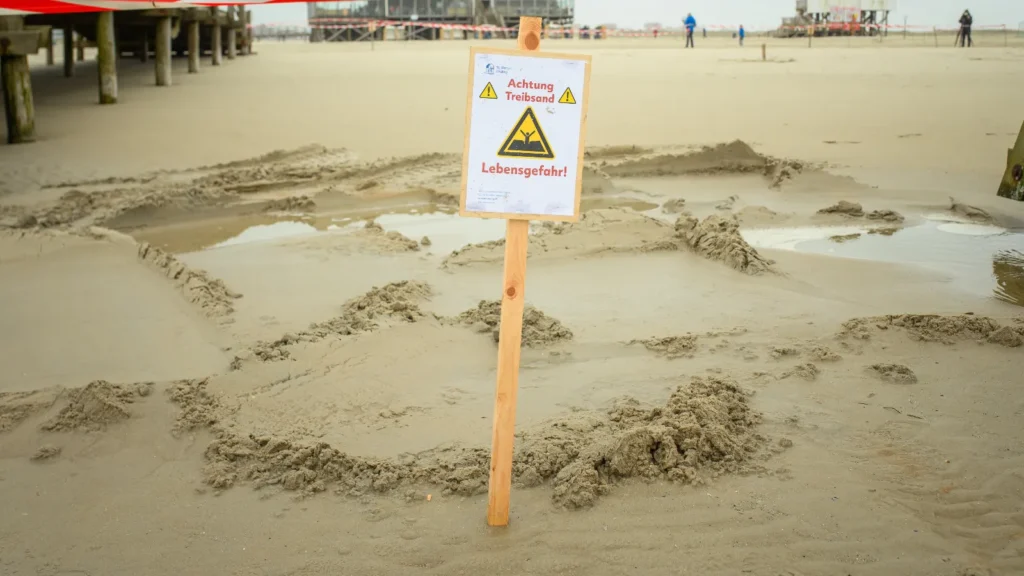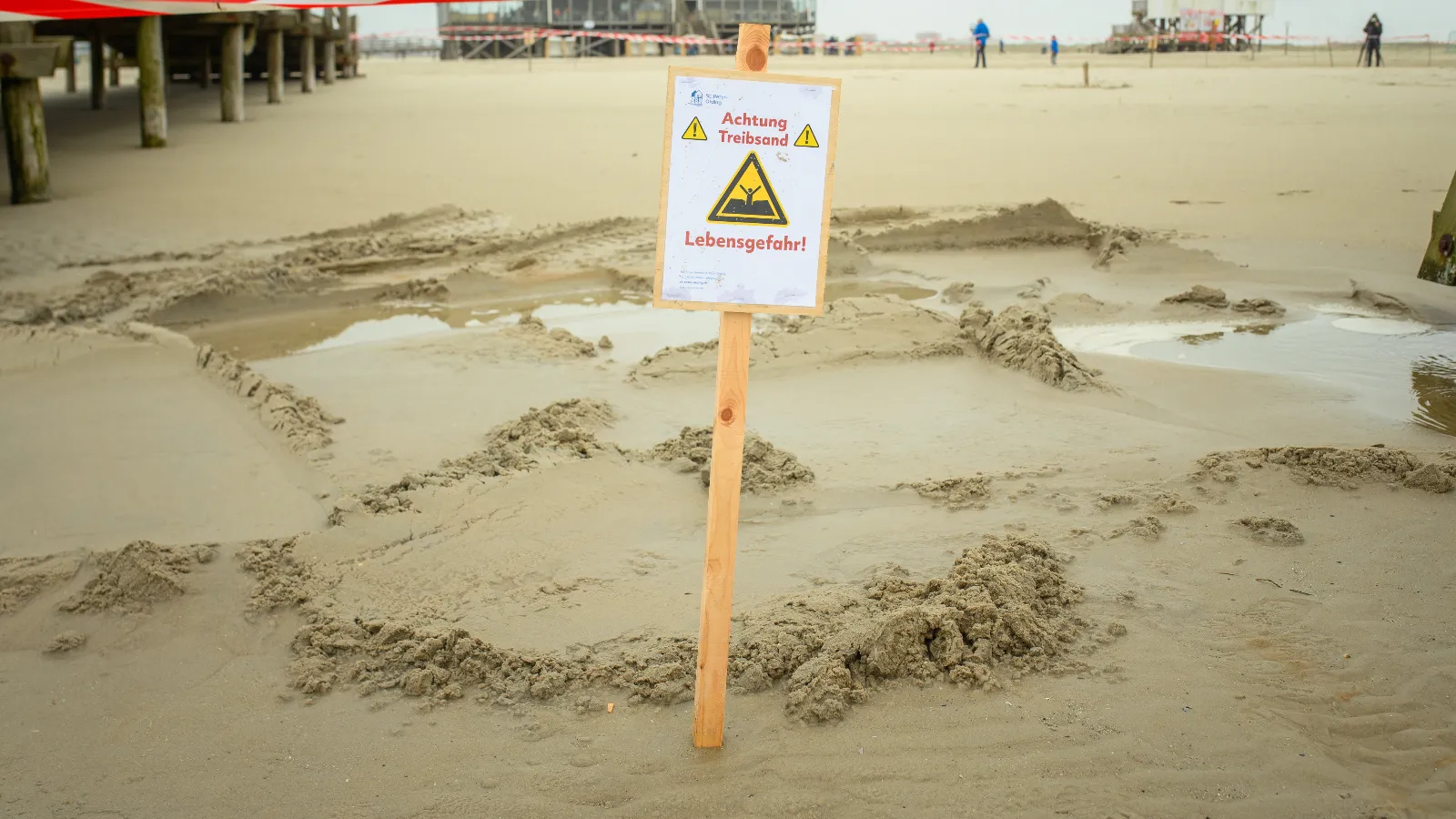woman swallowed by quicksand beach For many years, quicksand has been a common theme in adventure films and television series; it is frequently represented as a deadly, unavoidable trap that draws victims into a bottomless pit. But the real world is very different. Although it can be frightening, quicksand is not so much like a bottomless pit as it is thick mud. Usually, you won’t go all the way under, and you can safely pull yourself out with the correct information.
A woman called Jamie Acord and her spouse were strolling along a Maine beach in June when she stepped into quicksand. Her spouse was able to extricate her even though she had submerged up to her hips.
What should you do, then, if you ever find yourself in a situation like this? Here are some pointers and advice to keep you secure and composed.

Quicksand: What is it?
A combination of sand, water, and occasionally silt or clay is called quicksand. This kind of soil becomes liquefied and saturated, losing its ability to sustain weight. The combination becomes more fluid when pressure is applied, such when someone steps on it, and can imprison the person.
The Formation of Quicksand
In places where the sand is wet, like riverbanks, beaches, and marshes, quicksand usually accumulates. Water generates a suspension when it moves through the sand. Because the water separates the sand grains, there is less friction and the combination acts more like a liquid under pressure.
Typical Myths Regarding Quicksand
Myth: You’ll be totally submerged in quicksand.
Quicksand is frequently portrayed in films as a bottomless abyss that engulfs victims whole. It is impossible to fully sink in quicksand since its density is higher than that of the human body.
Myth: You Sink Faster When You Struggle
You may initially sink deeper when you struggle, but it’s not the hopeless flailing that movies portray. The secret is to stay composed and make methodical motions to get away.
Actual Events Associated with Quicksand Jamie Acord’s Experience
Jamie Acord went into quicksand while strolling on a Maine beach with her spouse in June. Her spouse came to her aid by pulling her out after she submerged up to her hips.
Other Prominent Occurrences
While there have been such cases, most people have managed to escape or been saved without suffering significant harm. Meetings with quicksand are frequently more of an annoyance than a death trap.
How to Spot Visual and Quicksand Clues
Although quicksand may appear slightly wetter or more fluid, it might nevertheless resemble ordinary mud or sand. Because of the water content, its surface may also shimmer.
Assessing the Terrain
Use a stick to gently poke the ground if you’re unsure. It could be quicksand if it gives way readily or feels especially soft.
How to Get Out of a Quicksand Trap and Remain Calm
Frantic motions brought on by panic can make you sink farther. Inhale deeply and make an effort to maintain composure.
Distribute Your Weight
To evenly distribute your weight across a broader area, lie back and spread your arms and legs. This keeps you from falling any lower.
How to Avoid Sudden Movements and Safely Escape Quicksand
Proceed with careful slowness. Pulling your legs straight up will create a vacuum and make it more difficult to get free. Try not to do this.
Make a Swimming Motion
Instead, try pushing yourself up and backward with your legs in a light swimming motion. This may assist you in rising to the surface.
Seize the Moment
Use any available object, like as a towel or branch, to help you slowly and firmly pull yourself out
Avoiding Quicksand Encounters: Follow Clearly Signposted Paths
Follow designated routes if you’re going to be trekking or walking in a quicksand-prone area. Steer clear of uncharted territory, especially when it’s close to marshes or riverbanks.
Recognize Your Environment
Keep an eye out for any visual cues that could point to the presence of quicksand. You can prevent yourself from walking into it by being watchful.
The Quicksand’s Scientific Basis
When water saturates a section of loose sand, less friction exists between the sand particles, forming quicksand. This results in a material that, when under pressure, acts like a liquid. By realizing this, quicksand can be less mysterious and cause needless anxiety.
Quicksand in Popular Culture Television Series and Films
Innumerable films and television series have used quicksand as a dramatic story element; it’s frequently portrayed as an unavoidable, lethal trap. Rapidsand is a common source of anxiety and misconceptions, partly because of this image.
Effect on Public Opinion
The public’s view has been formed by these overblown depictions, which make quicksand appear far more dangerous than it actually is. In actuality, quicksand is generally not life-threatening and is treatable with the correct information.
Quicksand Safety Advice
Keep your cool and go slowly.
Keeping your cool is essential. Making cautious, slow motions can make it easier for you to flee.
Balance Your Weight
To prevent sinking farther, distribute your weight. If you can, lie back to extend your surface area.
Ask for Assistance If Needed
Make an assistance call if you are unable to release yourself. In a quicksand encounter, having a partner can make a tremendous difference.

